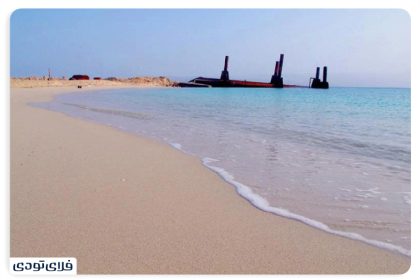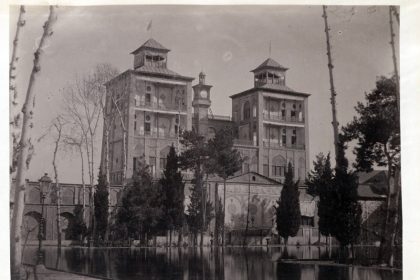The Forbidden City is located in the heart of Beijing, the capital of China, and is one of the most important and prominent historical places in this country. This city has a history of 600 years and the palace was the imperial residence during the 24 emperors in the Ming and Qing dynasties. The greatness and splendor of the architecture of this great complex led to its being registered as a UNESCO World Heritage Site and on the other hand, it became one of the main destinations for tourists around the world. In this article, we intend to learn more about this forbidden city and examine its details in detail. So if you are interested in the history of the great country of China and its historical places, read this article to the end.
General introduction of the forbidden city of China
The Forbidden City in China, also known as the Palace Museum, is a large complex of palaces located in Beijing, China. The area of the Forbidden City complex in China is 180 acres (72 hectares) and consists of 980 buildings and 9999 rooms, which is one of the largest and best preserved ancient wooden structures in the world. Around this complex, there are high walls and a moat, which were built to protect against external threats.
History of the Forbidden City of China
From the Ming Dynasty in 1420 to the end of the Qing Dynasty in 1912, the Forbidden City of China was the main residence of Chinese emperors and their families. The construction of the Forbidden City began in 1406 at the beginning of the Ming Dynasty under the rule of the Yongle Emperor. About one million workers have worked for 14 years to build this complex. About 200 years later, the Ming Dynasty fell and the Manchu King Dynasty came to power in 1644. Then in 1911, the King’s empire was also overthrown by the Republicans. Puy, as the last emperor after his abdication, was in the collection until 1924, when he was expelled due to a coup d’état. This complex has been the residence and government of 24 empires for 500 years.
This palace was designed as the political and ceremonial center of China. This city has been the political center of China for centuries. This collection was used in various uses such as government offices, ceremonial halls, libraries, gardens and squares for thousands of people.
In 1987, this collection was registered as a UNESCO World Heritage Site due to its background and cultural value. This collection is considered one of the best examples to see the ancient architecture of Chinese palaces and magnificent buildings.

View China tour price
How the city was banned
China’s Forbidden City is a forbidden city due to visitor restrictions. The name of the Forbidden City is a translation of the Chinese phrase Zin Cheng, which means Purple Forbidden City. The reason for giving this name to this complex was that it was forbidden for people to enter the complex of ancient palaces during the ancient era. Since the aim of the Chinese Empire was to consolidate its power in one place to carry out imperial political and ceremonial affairs, the imperial soldiers and security forces tried their best to prevent ordinary people from entering this complex.
Read more…
Introducing the Red Coast of China
The exact location of the Forbidden City in China
The Forbidden City of China is built in the center of Beijing and is located in the Dongcheng District of Beijing on Jingshen Street. There are many reasons for choosing this point as the center of the Chinese empire from a strategic point of view. This complex has been the symbolic center and center of interactions and political and ceremonial decisions of the Chinese Empire. Its central position has been indicative of the centrality of the supreme power of the emperor and his authority over the entire country.
One of the other criteria in choosing this place was paying attention to the principles of Feng Shui. Feng Shui is an ancient Chinese method and approach whose purpose was to create harmony between human-made structures with the surrounding environment and the flow of positive energy. In the Forbidden City, there are many complications and natural features that create positive energy in this environment.
Also, the use of high walls, ditches, and strong materials has made the Forbidden City of China a strong fortress against the onslaught of opponents and enemies of the empire.

Pictures and historical documents from the forbidden city
Studying historical documents makes researchers and historians know the rich cultural heritage and political changes of ancient China. These documents help preserve and interpret the Forbidden City as an important cultural artifact and help reveal the secrets behind each of the complex’s walls.
The historical documents related to the Forbidden City provide valuable insights into the way of life of the Chinese empires, their families and the entire courtiers, and the changes in the area of the Forbidden City complex. These documents include imperial decrees and laws, history and official documents, correspondence of all officials in different periods of different empires, architectural plans and maps, and personal diaries and diaries.
Official decrees and decrees were issued by the emperors and were presented as government decrees in matters such as governance, appointment of officials, promotion of executive and military officials, punishments of officials and other important matters of governance.
Official historical documents and files include various aspects of government actions, including ceremonies, religious ceremonies, and diplomatic interactions. These documents are about the daily activities and responsibilities of the empire and its officials.
Correspondence between emperors and their ministers, as well as foreign ambassadors, shows the diplomatic relations and exchanges between China and other countries during different historical periods.
Architectural plans and maps provide detailed information about the placement, design, and construction of China’s Forbidden City. These maps provide valuable information about traditional Chinese architecture, urban planning and design, and engineering techniques used at the time.
The personal notes and memoirs of the emperors or their relatives contain more interesting and autobiographical information about their thoughts, feelings, and personal experiences. In some of these notes, details about their daily activities, hobbies, interests, and relationships with family members, courtiers, and the emperor’s entourage are discussed.
Click to see the price and buy a tour of China from Star Vank.
Buy a tour of China
Discovering the Forbidden City: Adventures and Explorations
Exploring the Forbidden City is like walking through history and discovering the secrets of ancient China. As visitors pass through the grand gates and enter the palace complex, they enter a world of splendor and luxury.
The Forbidden City is the center of a large collection of treasures and historical monuments. In the palace museum, there are about one million historical objects such as paintings, calligraphy, ceramics, and imperial clothing. These objects confirm the rich and magnificent culture of China and can tell the way of life of the emperors and their families.
While exploring China’s Forbidden City, one can see secret gardens and a flat lake between the walls of the complex. These static and motionless spaces were considered as personal resting places for emperors and their mistresses. By walking along winding paths and crossing glittering bridges, visitors can experience relaxing moments in this cozy and quiet complex.

Antiquities and architecture of the forbidden city
The palace complex of the Forbidden City of China has 980 buildings, which is considered the largest imperial palace in the world. The architecture of the Forbidden City is a masterpiece of traditional Chinese design with symmetrical placement and colorful decoration.
These buildings are built with traditional materials such as wood and stone, and the roofs of the buildings have ornate decorations and paintings and attractive shiny tiles. Attention to details and skill in every aspect of architecture has made this collection even more attractive and glorious.
In traditional Chinese buildings, instead of height, more attention is paid to the width of the structure, and this issue is more evident in the magnificent and luxurious buildings. These buildings often have a closed and heavy platform with a large roof, and vertical support walls are not used.
Red color has been used in many architectural elements of the buildings of the Forbidden City, because according to the Chinese people, this color is a good luck factor. Palaces and palaces have short roofs compared to western architecture.
The land of the forbidden city is rectangular with sides of 961 meters (3153 feet) from north to south and 753 meters (2470 feet) from east to west. Around this complex, walls with a height of 7.9m (26 feet) and moats with a depth of 6 meters (20 feet) and a width of 52 meters (171 feet) have been built.
The most prominent architectural elements of the Forbidden City of China
One of the most prominent architectural elements of the Forbidden City in China is the use of Wu (gate or passage) and the construction of the southern entrance at a height of 38 meters (125 feet). This gate opens to a large area where the Golden River is located and five marble bridges are also built in this area.
The construction of the emperor’s hall with a height higher than the outer area is considered its most significant part. This building is the largest building in the complex and is the largest wooden structure in China. Next to the three halls of the inner area, the imperial garden with an area of 3 acres has been built, which was a place for the emperor and his family to rest and relax.
The structures of the Chinese Forbidden City complex are built with timber from the forests of southwest China and large blocks of marble. Golden bricks have been used for the floor of several important halls. Shiny yellow tiles were used on the roofs.
After the complex was completed in 1420, 14 Ming emperors and 10 Qing emperors used this complex as their imperial palace. But after 1912 and the fall of Emperor Pui, the centrality and political use of this collection in China ended. In 1925, the Palace Museum was established and dominated the entire complex of the Forbidden City. Today, the palace museum is considered as a large collection of precious and artistic works and objects, including the collection of objects from the Ming and Qing dynasties. Of course, this museum is still the most visited museum in the world with 14.6 million visitors per year.
Read more…
20 tips before traveling to China
The influence of the Forbidden City on Chinese culture and history
Undoubtedly, we cannot ignore the significant role of the Forbidden City in China’s civilization and culture. The architectural elements used in all parts of the Forbidden City show the richness of Chinese culture. The design of the large roofs of the Forbidden City has a deep cultural significance. The presence of sloping roofs, which slope downwards from all directions, speaks of the social hierarchy culture of a building in the residence of the emperor and courtiers.
Also, the colors used by the designers in the Forbidden City of China are indicative of cultural and aesthetic purposes. In ancient times, Chinese designers used the concept of wu xing, which affirms the occurrence of certain events based on the interaction between different components. This approach was used in various fields of science, health, architecture and martial arts. Wu Jing originally relied on the five elements (metal, wood, water, fire, and earth), but later on, the directions and colors (green, blue, yellow, red, white, and black) were applied, each with significant significance. they had.
The Chinese had great faith in astrology and used it in the design of the Forbidden City. For example, the number nine is the largest odd number, and along with the color yellow, it has been the focus of many designers.

The role of the forbidden city in Chinese literature and legends
The cultural and historical importance of the Forbidden City of China caused this historical work to be inspired in many literary works, including poems, novels and literary collections. Many prominent Chinese writers and poets have mentioned the Forbidden City complex in their works. For example, Li Bai, a famous Chinese poet, wrote a poem called Visiting the Forbidden City that praised the beauty and grandeur of the Imperial Palace. This city is one of the classic poems of Chinese literature and expresses the nature of the forbidden city and its effect on visitors.
In addition to poetry, the Forbidden City has appeared in various novels and historical drama works. In these literary works, the life of the emperors, their mistresses and the courtiers in the palace are mentioned, and the readers get a brief knowledge of the war and the power struggle between the courtiers and their interaction. These stories have become a part of Chinese literature and have caused the formation of cultural recognition of the Forbidden City of China.
In addition, legends and folklore related to the forbidden city have added to its cultural importance. Many legends and stories have been told about the Forbidden City over the centuries. These legends represent people’s fantasy and imagination and have become a part of Chinese folklore and have added to the spiritual fame and charm of the Forbidden City.
Read more…
What are the giant statues of China?
How to Visit the Forbidden City: A Tourist Guide
To visit the Forbidden City, you must first know the opening hours of this complex and purchase a visit ticket from the official website or through a well-known travel agency.
The Forbidden City is closed on Mondays, except for national days in China.
The maximum number of visitors per day is 80,000 people. Tickets usually sell out quickly every day during peak seasons. It is not possible to buy tickets on the spot and you have to buy them online.
November 1 to March 31 | April 1 to October 31 | Date |
08:30-16:30 | 08:30-17:00 | Visiting hours |
Morning 08:30-13:10 Evening 13:00-15:40 | Morning 08:30-13:10 Evening 13:00-16:10 | arrival time |
Nimroz Gate is the main entrance for tourists. There are three ways to reach the Forbidden City:
- Subway: Take subway line 1 and get off at Tiananmen West (Exit B) or Tiananmen East Station (Exit B).
- Bus: Take bus number 2, 82 or 120 and get off at Tiananmen East Station.
- Taxi: Use the letters ‘请带我去故宫’ (Please take me to the Forbidden City).
To attend during non-busy hours, we suggest:
- If you don’t mind the cold and dry weather of Beijing in winter, try to visit this place in this season. Based on our experience, the best time to visit this complex is from mid-October to the end of November.
- Do not use the central axis because most of the big Chinese tours use it.
- In general, the peak season for visiting the Forbidden City is between April and October and the quiet months are between November and March.

The Future of the Forbidden City: Conservation and Restoration
The improvement and restoration of the Forbidden City of China as one of the most important historical monuments of this country is vital for future generations. In terms of maintenance, you should have maximum protection of physical structures, precious objects and the overall integrity of the palace complex. Various methods such as regular maintenance, maintenance projects and protective techniques should be used to prevent deterioration caused by natural elements and human activities.
Regarding improvement, it is important to improve the experiences of tourists in order to respect and observe the historical and cultural value of the forbidden city as much as possible. In this regard, you can think about improving facilities, implementing sustainable tourism approaches, and improving educational programs to spread more knowledge about the history and importance of the Forbidden City complex.
In addition, progress in the field of technology plays an effective role in the future of the Forbidden City. Digital preservation methods, augmented reality experiences, and interactive exhibits open up new ways for visitors to experience the site and learn about its rich heritage.
Read more…
All about Chinese New Year
final word
The Forbidden City of China is considered one of the most important ancient monuments of this country. This historical work has played a very important role both in history and in the culture of the people and elites of Chinese society. The Chinese Palace Museum is considered the most visited museum in the world, with millions of people from all over the world visiting this magnificent historical complex. Crowding and mass of visitors make visiting this complex not suitable for some tourists. Therefore, it is possible to visit this rare collection in the quiet months of the year, as mentioned in this article.
Click to see the price and buy a tour of China from Star Vank.
Buy a tour of China
Copying of the contents of Setare Vanak Airline Agency is prohibited only by mentioning the source.
RCO NEWS















